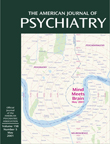A Randomized Double-Blind Study of Risperidone and Olanzapine in the Treatment of Schizophrenia or Schizoaffective Disorder
Abstract
OBJECTIVE: The safety and efficacy of risperidone and olanzapine were compared in a double-blind trial that used doses widely accepted in clinical practice. METHOD: Subjects (N=377) who met DSM-IV criteria for schizophrenia or schizoaffective disorder were randomly assigned to receive 2–6 mg/day of risperidone (mean modal dose=4.8 mg/day) or 5–20 mg/day of olanzapine (mean modal dose=12.4 mg/day) for 8 weeks. RESULTS: The two study groups were similar at baseline except that the olanzapine group was slightly younger than the risperidone group. Seventy-five percent of the participants completed the trial, with no between-treatment differences in the proportion of dropouts. Similar proportions of the risperidone and olanzapine groups reported extrapyramidal symptoms (24% and 20%, respectively). Severity of extrapyramidal symptoms was low in both groups, with no between-group differences. Total Positive and Negative Syndrome Scale scores and scores on the five Positive and Negative Syndrome Scale factors were improved in both groups at week 8 (subjects who completed the study) and endpoint (all subjects, including dropouts). There were overall between-treatment differences in efficacy. Comparison of individual factors found no significant differences at endpoint; at week 8, however, improvements on Positive and Negative Syndrome Scale factors for positive symptoms and anxiety/depression were greater with risperidone than olanzapine. An increase in body weight of ≥7% was seen in 27% of olanzapine participants and 12% of risperidone participants. CONCLUSIONS: Both treatments were well tolerated and efficacious. The frequency and severity of extrapyramidal symptoms were similar in the two treatment groups. Greater reductions in severity of positive and affective symptoms were seen with risperidone than with olanzapine treatment among study completers. There was no measure on which olanzapine was superior. Greater weight gain was associated with olanzapine than with risperidone treatment.



